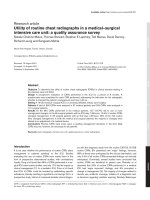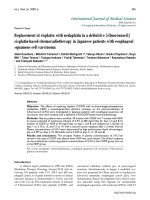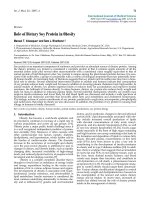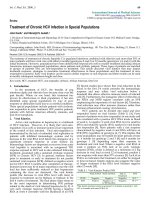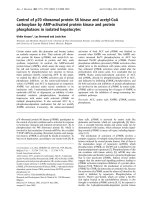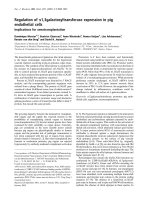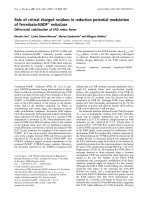Báo cáo y học: " Introduction of Medical Emergency Teams in Australia and New Zealand: a multi-centre study"
Bạn đang xem bản rút gọn của tài liệu. Xem và tải ngay bản đầy đủ của tài liệu tại đây (313.39 KB, 8 trang )
Open Access
Available online />Page 1 of 8
(page number not for citation purposes)
Vol 12 No 2
Research
Introduction of Medical Emergency Teams in Australia and New
Zealand: a multi-centre study
Daryl Jones
1
, Carol George
2
, Graeme K Hart
2
, Rinaldo Bellomo
1,3
and Jacqueline Martin
4
1
Australian and New Zealand Intensive Care Research Centre, Department of Epidemiology and Preventive Medicine, Monash University, 89
Commercial Road, Melbourne 3004, Victoria, Australia
2
Australian and New Zealand Intensive Care Society Adult Patient Database, 10 Ievers St, Carlton, Melbourne, Victoria 3053, Australia
3
Intensive Care Research and Staff Specialist Intensive Care, Austin Hospital, Studley Rd, Heidelberg, Melbourne, Victoria 3084, Australia
4
Australian and New Zealand Intensive Care Society Research Centre for Critical Care Resources, 10 Ievers St, Carlton, Melbourne, Victoria 3053,
Australia
Corresponding author: Rinaldo Bellomo,
Received: 23 Oct 2007 Revisions requested: 9 Jan 2008 Revisions received: 5 Mar 2008 Accepted: 7 Apr 2008 Published: 7 Apr 2008
Critical Care 2008, 12:R46 (doi:10.1186/cc6857)
This article is online at: />© 2008 Jones et al.; licensee BioMed Central Ltd.
This is an open access article distributed under the terms of the Creative Commons Attribution License ( />),
which permits unrestricted use, distribution, and reproduction in any medium, provided the original work is properly cited.
Abstract
Introduction Information about Medical Emergency Teams
(METs) in Australia and New Zealand (ANZ) is limited to local
studies and a cluster randomised controlled trial (the Medical
Emergency Response and Intervention Trial [MERIT]). Thus, we
sought to describe the timing of the introduction of METs into
ANZ hospitals relative to relevant publications and to assess
changes in the incidence and rate of intensive care unit (ICU)
admissions due to a ward cardiac arrest (CA) and ICU
readmissions.
Methods We used the Australian and New Zealand Intensive
Care Society database to obtain the study data. We related
MET introduction to publications about adverse events and MET
services. We compared the incidence and rate of readmissions
and admitted CAs from wards before and after the introduction
of an MET. Finally, we identified hospitals without an MET
system which had contributed to the database for at least two
years from 2002 to 2005 and measured the incidence of
adverse events from the first year of contribution to the second.
Results The MET status was known for 131 of the 172 (76.2%)
hospitals that did not participate in the MERIT study. Among
these hospitals, 110 (64.1%) had introduced an MET service by
2005. In the 79 hospitals in which the MET commencement
date was known, 75% had introduced an MET by May 2002. Of
the 110 hospitals in which an MET service was introduced, 24
(21.8%) contributed continuous data in the year before and after
the known commencement date. In these hospitals, the mean
incidence of CAs admitted to the ICU from the wards changed
from 6.33 per year before to 5.04 per year in the year after the
MET service began (difference of 1.29 per year, 95%
confidence interval [CI] -0.09 to 2.67; P = 0.0244). The
incidence of ICU readmissions and the mortality for both ICU-
admitted CAs from wards and ICU readmissions did not
change. Data were available to calculate the change in ICU
admissions due to ward CAs for 16 of 62 (25.8%) hospitals
without an MET system. In these hospitals, admissions to the
ICU after a ward CA decreased from 5.0 per year in the first year
of data contribution to 4.2 per year in the following year
(difference of 0.8 per year, 95% CI -0.81 to 3.49; P = 0.3).
Conclusion Approximately 60% of hospitals in ANZ with an ICU
report having an MET service. Most introduced the MET service
early and in association with literature related to adverse events.
Although available in only a quarter of hospitals, temporal trends
suggest an overall decrease in the incidence of ward CAs
admitted to the ICU in MET as well as non-MET hospitals.
Introduction
Rapid Response Systems (RRSs) have been introduced into
hospitals to identify and treat at-risk ward patients in an
attempt to reduce unplanned intensive care unit (ICU)
admissions and cardiac arrests (CAs) [1-3]. In Australia and
New Zealand (ANZ), the most common form of RRS is the
ICU-based Medical Emergency Team (MET) system, first
described by Lee and colleagues in 1995 [4]. METs have
been shown to reduce the incidence of in-hospital CAs in a
number of single-centre before-and-after studies [5-9]. A
ANZ = Australia and New Zealand; ANZICS = Australian and New Zealand Intensive Care Society; ANZICS-APD = Australian and New Zealand
Intensive Care Society Adult Patient Database; APD = Adult Patient Database; ARCCCR = Australian and New Zealand Intensive Care Society
Research Centre for Critical Care Resources; CA = cardiac arrest; ICU = intensive care unit; IHI = Institute of Health Improvement; MERIT = Medical
Emergency Response and Intervention Trial; MET = Medical Emergency Team; RRS = Rapid Response System.
Critical Care Vol 12 No 2 Jones et al.
Page 2 of 8
(page number not for citation purposes)
recently published cluster randomised controlled trial (the
Medical Emergency Response and Intervention Trial [MERIT]
[10]) involving 23 Australian hospitals, however, did not con-
firm this finding.
In the United States, RRSs have been introduced into multiple
hospitals in response to the '5 Million Lives campaign' pro-
moted by the Institute of Health Improvement (IHI) [11]. On the
other hand, the degree of uptake and factors affecting the
introduction of MET services into hospitals in ANZ are not well
described. Similarly, no aggregate information exists on how
the introduction of MET systems might have affected relevant
outcome measures outside the setting of the cluster ran-
domised trial, a comparative study of three hospitals, or single-
centre before-and-after studies.
The Australian and New Zealand Intensive Care Society
(ANZICS) Research Centre for Critical Care Resources
(ARCCCR) maintains a database recording information on
critical care resources, including the timing of introduction of
METs. In addition, ANZICS maintains an Adult Patient Data-
base (ANZICS-APD), which currently contains information on
the demographics, admissions source, and outcomes of more
than 450,000 ICU admissions. The development and details
of the ANZICS-APD have been described in detail elsewhere
[12].
The aims of this study were (a) to describe the timing and
extent of the introduction of MET services into ANZ hospitals
in relation to relevant publications, (b) to assess the associa-
tion between MET service introduction and the incidence and
rate of ICU admissions due to ward CAs, (c) to assess the
association between MET service introduction and the inci-
dence and rate of ICU readmissions, and (d) to assess
changes in the same adverse events in hospitals that had not
introduced an MET service.
Materials and methods
Ethical considerations
The collection, analysis, and reporting of de-identified data by
the ANZICS-APD comply with Australian Commonwealth leg-
islation (1994) enabling national quality assurance activities.
They also comply with the quality assurance amendment of the
Australian Health Insurance Act (1973) [12]. This enables eth-
ical approval for research projects to be undertaken using the
information contained within the database.
Assessment on timing of introduction of MET service
We obtained information from a database maintained by the
ANZICS ARCCCR and derived from surveys of ICU resources
and activity. The information related to the timing of com-
mencement of an MET into hospitals in ANZ which were not
involved in the MERIT study [10]. Hospitals in this database
are characterised by the presence of an ICU and were catego-
rised into 'MET: commencement date known', 'MET: com-
mencement date unknown', 'No MET service', or 'MET status
unknown'. Graphs were constructed to display the cumulative
uptake of METs with time between the period from February
1995 to May 2005. The timing of commencement was
assessed for hospitals overall and separately for 'metropoli-
tan', 'private', 'rural/regional', and 'tertiary' hospitals as classi-
fied in the ARCCCR database.
MET service commencement in relation to publications
An electronic search was conducted to identify literature
related to serious adverse events and METs to assess the tim-
ing of MET introduction in relation to such literature. Studies
were selected from a Medline search from 1990 to 2006
using the key words 'adverse event', 'medical emergency
team', 'cardiac arrest', and 'rapid response team'. The date of
these publications was then related to the timing of com-
mencement of MET services.
Assessment of the effect of MET service commencement
on adverse events
The ANZICS-APD was interrogated to obtain data on the inci-
dence of ICU admissions secondary to CAs in ward patients
and on the incidence of readmissions to the ICU.
Hospital eligibility criteria
Hospitals were eligible for analysis if they had an MET service
with a known commencement date and had contributed to the
ANZICS-APD for the two continuous years spanning the intro-
duction of the MET service (12 months before and 12 months
after). Hospitals were excluded from analysis if they were par-
ticipants in the MERIT study [10], if the MET status or time of
MET commencement was unknown, or if they had no events
recorded at baseline.
Definition of adverse events and data extraction from
ANZICS-APD
The APD was interrogated using commercially available soft-
ware (SAS for Windows; SAS Institute Inc., Cary, NC, USA)
for data in the 12 months before and 12 months after com-
mencement of the MET service. In the case of ward CAs, the
patient cohort was constructed by restricting the 'ICU admis-
sion source' field to 'patients admitted from the ward' and
restricting the 'admission diagnostic codes' field to the
APACHE (Acute Physiology and Chronic Health Evaluation) III
'non-operative diagnostic code 114 – post cardiac arrest'. The
cohort of patients experiencing ICU readmission was con-
structed by including all patients admitted to the ICU on two
or more occasions in the same hospital admission, regardless
of admissions source. We also obtained information on the
overall number of ICU admissions and the hospital mortality of
patients admitted after a ward CA or readmission.
We assessed similar changes in hospitals that had contrib-
uted at least 24 months of data to the APD during the same
period (2000 to 2005) but had not introduced an MET service
Available online />Page 3 of 8
(page number not for citation purposes)
and had not participated in the MERIT study by comparing the
first year of data submission to the second. Finally, in an addi-
tional sensitivity assessment, we extended our analysis to hos-
pitals involved in the MERIT study which had submitted
information to the APD before participation in the MERIT study
and which had continued to submit data thereafter.
Data analysis and statistics
Descriptive data are presented as raw numbers and as a per-
centage of overall cases or events. Data on adverse events
(ICU admission due to ward CA and readmission to ICU) are
presented as means ± standard deviation for absolute values
and rates of events (adjusted for total ICU admissions) in the
12-month periods before and after the commencement of the
MET service.
The difference in the incidence and hospital mortality for
adverse events before and after commencement of the MET
was tested for with the Wilcoxon signed rank test. A similar
comparison was performed for hospitals that had not intro-
duced an MET service using the first year of data as baseline
and the second year as comparator. Finally, an additional and
similar analysis was performed for hospitals that had partici-
pated in the MERIT study. A P value of less than 0.05 was con-
sidered statistically significant.
Results
MET service status in 'non-MERIT' ANZ hospitals
The MET status was known for 131 of the 172 (76.2%) ANZ
hospitals that did not participate in the MERIT study (Table 1).
The proportion of cases in which the MET status was known
varied from 66.7% (private hospitals) to 96% (tertiary hospi-
tals) depending on hospital category. In 94% of hospitals with
an MET service, the commencement date was known (Figure
1, Table 1).
In the 131 'non-MERIT' hospitals in which the MET status was
known, 64.1% of hospitals stated that an MET service had
been introduced (Figure 1, Table 2). In these hospitals, the
proportion of hospitals with an MET service varied from 62.5%
(regional) to 72.5% (private) depending on hospital category
(Table 2).
Timing of MET service commencement in relation to
publications
In the 79 hospitals in which the MET commencement date was
known, 75% of MET services had commenced by May 2002
(Figure 2). A similar pattern of uptake was seen for all hospital
categories (Figure 3). Prior to May 2002, there were three
publications related to the MET and several publications
describing antecedents to serious adverse events in hospital
patients [13-18].
Effect of MET service commencement on adverse events
Of the 79 hospitals in which the MET service commencement
date was known, 29 had also contributed continuous data to
the ANZICS-APD in the year before and after the date of MET
service introduction (Figure 1). In these 29 hospitals, sufficient
data on CAs were available in 24. In these 24 hospitals, there
was a statistically significant reduction (P = 0.0244) in the
incidence of ward CAs admitted to the ICU in the year after the
introduction of an MET service. A similar decrease was seen
in their rate (events per 1,000 admissions) (Table 3).
The rates of survival to hospital discharge for patients admitted
to the ICU after a ward CA were 37.9% before the introduc-
tion of the MET and 38.3% after the introduction of the MET
(P = 0.779) (Table 4). There was no statistically significant
reduction in the incidence of ICU readmissions (Table 3) or
hospital survival of ICU readmissions in association with the
introduction of the MET service into the hospitals studied
(Table 4).
Adverse events in hospitals without an MET service
We identified 47 hospitals with no MET service (Figure 1). Of
these, 16 had contributed data for two years during the period
from 2002 to 2005 and did not participate in the MERIT study:
4 private hospitals, 6 metropolitan hospitals, 2 regional hospi-
Table 1
Medical Emergency Team (MET) service status in 172 hospitals in Australia and New Zealand
Hospital category MET service
commencement date
known
MET service
commencement date
unknown
No MET service MET status unknown,
number (percentage
of total
a
)
Total
All hospitals 79 5 47 41 (23.8) 172
Metropolitan 18 1 13 3 (8.6) 35
Private 28 1 11 20 (33.3) 60
Regional 18 3 14 17 (32.7) 52
Tertiary 15 0 9 1 (4) 25
Hospitals participating in the Medical Emergency Response and Intervention Trial are not included in the data above.
a
'Total' refers to the total
number of hospitals in each hospital category.
Critical Care Vol 12 No 2 Jones et al.
Page 4 of 8
(page number not for citation purposes)
tals, and 4 tertiary hospitals. In these hospitals, data were
obtained for the years 2002 to 2005. When comparing the
first year with sufficient data to the following year, we found a
decrease in the incidence of CAs from 5 to 4.2 per year (P =
0.3). Similar to MET hospitals, there was no change in other
outcome measures (Table 5).
MERIT hospitals
Twenty-three hospitals participated in the MERIT study. Of
those randomly assigned to an MET service (n = 12), all con-
tinued to have an MET system in 2007. Of those randomly
assigned to the control arm (n = 11), five had introduced an
MET service by 2005. Twelve hospitals could be identified
which participated in MERIT, had an MET system, contributed
to the database, and had contributed data for at least one year
before the introduction of the MET and one year thereafter. Six
hospitals could be identified which participated in MERIT, did
not have an MET system, contributed to the database, and had
contributed data for at least two consecutive years during our
study period. These hospitals showed no temporal trends in
readmission rates. However, both control hospitals and MET
hospitals showed a trend toward a decreased percentage of
ICU admissions being secondary to CAs (P = 0.11 and P =
0.1, respectively). When hospitals were analysed in their
aggregate, this temporal trend was statistically significant (P =
0.023).
Discussion
Summary of study findings
We studied the introduction of MET services into 172 hospi-
tals in ANZ which did not participate in the MERIT study [10]
and assessed the association between this introduction and
the pattern of adverse events. We similarly and separately also
assessed hospitals from the MERIT study. Information on MET
status was available in more than three quarters of hospitals
and approximately 60% of these had introduced an MET serv-
ice. Most hospitals introduced MET services following publica-
tions related to adverse events rather than after studies
reporting the effectiveness of the MET. In hospitals (n = 24) for
which information was available, the incidence of CAs was
lower in the year after the introduction of the MET service com-
pared with the year before its introduction. No changes were
seen in other outcome measures. Similar changes were found
in a cohort of hospitals that had not introduced an MET service
and in hospitals that participated in the MERIT study.
Timing of introduction of MET services
In the United States, the IHI emphasised that RRSs were an
integral part of the 100,000 Lives Campaign, which com-
menced in January 2005 [19,20]. They subsequently reported
that 100 hospitals have implemented an RRS and that more
than half of the 2,500 hospitals that joined the campaign said
they intended to follow suit [19]. In the present study of hospi-
tals in ANZ, most MET services were introduced before May
2002. Prior to this date, only one publication [6] reported a
reduction in the incidence of unexpected CAs in association
Figure 1
Flow diagram of the Medical Emergency Team (MET) status of 172 hospitals in Australian and New Zealand with intensive care unitsFlow diagram of the Medical Emergency Team (MET) status of 172
hospitals in Australian and New Zealand with intensive care units. The
diagram does not include hospitals participating in the Medical Emer-
gency Response and Intervention Trial. ANZICS-APD, Australian and
New Zealand Intensive Care Society Adult Patient Database.
Table 2
Proportion with and without a Medical Emergency Team (MET) amongst hospitals with information on MET status
Hospital category MET service present No MET service Percentage with MET service
a
All hospitals 84 47 64.1
Metropolitan 19 13 59.4
Private 29 11 72.5
Regional 21 14 62.5
Tertiary 15 9 64.1
a
Indicates the percentage with MET service only for 131 'non-MERIT' hospitals in which the MET status of the hospital is known. MERIT, Medical
Emergency Response and Intervention Trial.
Available online />Page 5 of 8
(page number not for citation purposes)
with the introduction of an MET service. Other studies of the
MET published in this period either described the MET as a
concept [1] or failed to show a reduction in CAs in association
with MET service introduction [13]. These findings suggest
that most hospitals that have introduced an MET service did so
primarily in response to presentations by opinion leaders or to
studies describing antecedents to unexpected CAs and
unplanned ICU admissions.
Effect of MET service introduction on adverse events
Our study identified that the introduction of an MET service
was associated with a significant reduction in the incidence
and rate of ICU admissions due to a ward CA. However, this
effect could be measured in only 24 of the 84 hospitals with
an MET service. We are unable to comment on changes in the
incidence of CAs in hospitals that did not fulfil these criteria or
where the MET status was unknown. In a small and unmatched
cohort of hospitals (n = 16) without an MET which contributed
24 months of consecutive data during the same time frame,
however, similar changes in outcome were seen. Finally, we
also obtained information on those hospitals that had partici-
pated in the MERIT study and had contributed sufficient data
for analysis. We found that 5 of 11 MERIT control hospitals
had introduced an MET system and that the temporal trends
toward reduced CA admission to the ICU seen in the main
cohort were confirmed in MERIT hospitals.
Study strengths and limitations
To our knowledge, this is the only study to assess the imple-
mentation of METs in two countries and the timing of such
implementation. It is also the first to seek to relate the introduc-
tion of METs to available evidence. It is also the first multi-cen-
tre before-and-after comparison in a broad cohort of hospitals
for relevant outcomes in a 'real life' setting outside of trial-mod-
ified situations. As such, it provides some insights into the trig-
gers and consequences of the process of translating research
into practice. We believe that the information we obtained may
provide a perspective on the possible applicability and gener-
alisability of clinical research in general and of research on the
MET/RRS in particular.
Despite the above features, the study is retrospective and
observational, with all of the associated limitations. We are
able to comment on the uptake of MET services until April
2005 only and cannot assess the effect of the publication of
the MERIT study [10] (published June 2005), which failed to
show a beneficial effect of METs, on the subsequent introduc-
tion or possible removal of MET services. In addition, the MET
status is known for only three quarters of the 172 ICU-
equipped 'non-MERIT' hospitals in ANZ. It is possible that, if
the missing 25% provided information, our findings would be
altered. We were able to study only 29 hospitals, a relatively
small number of the overall initial cohort (Figure 1). Thus, our
findings may not be widely applicable or fully representative.
The assessment of the possible effect of the MET service on
ICU admissions due to ward CAs and unplanned ICU admis-
Figure 2
Uptake of Medical Emergency Team (MET) services into those hospi-tals in Australia and New Zealand for which the MET status is knownUptake of Medical Emergency Team (MET) services into those hospi-
tals in Australia and New Zealand for which the MET status is known.
Each data point represents the cumulative total of MET services com-
menced (y-axis) at the corresponding time (x-axis). The commencement
of the MET service at Liverpool Hospital (University of New South
Wales, Sydney, Australia) (June 1989) is omitted for the purpose of
presentation. Shown below the x-axis are the first authors of publica-
tions related to adverse events and METs: Lee, et al. [4]; McQuillan,
etal. [16]; Smith and Wood [17]; Buist, et al. [14]; Goldhill, et al. [15];
Bristow, et al. [13]; Buist, et al. [6]; Hodgetts [21]; Foraida [22]; Bel-
lomo, et al. [5]; and DeVita [7].
Figure 3
Uptake of Medical Emergency Team (MET) services into various cate-gories of hospitals in Australia and New Zealand for which the MET sta-tus is knownUptake of Medical Emergency Team (MET) services into various cate-
gories of hospitals in Australia and New Zealand for which the MET sta-
tus is known. Each data point represents the cumulative total of the
number of MET services commenced (y-axis) at the corresponding time
(x-axis). The commencement of the MET service at Liverpool Hospital
(University of New South Wales, Sydney, Australia) (June 1989) is
omitted for the purpose of presentation. Shown below the x-axis are the
first authors of publications related to adverse events and METs: Lee,
et al. [4]; McQuillan, et al. [16]; Smith and Wood [17]; Buist, et al. [14];
Goldhill, et al. [8]; Bristow, et al. [13]; Buist, et al. [6]; Hodgetts [21];
Foraida [22]; Bellomo, et al. [5]; and DeVita [7].


